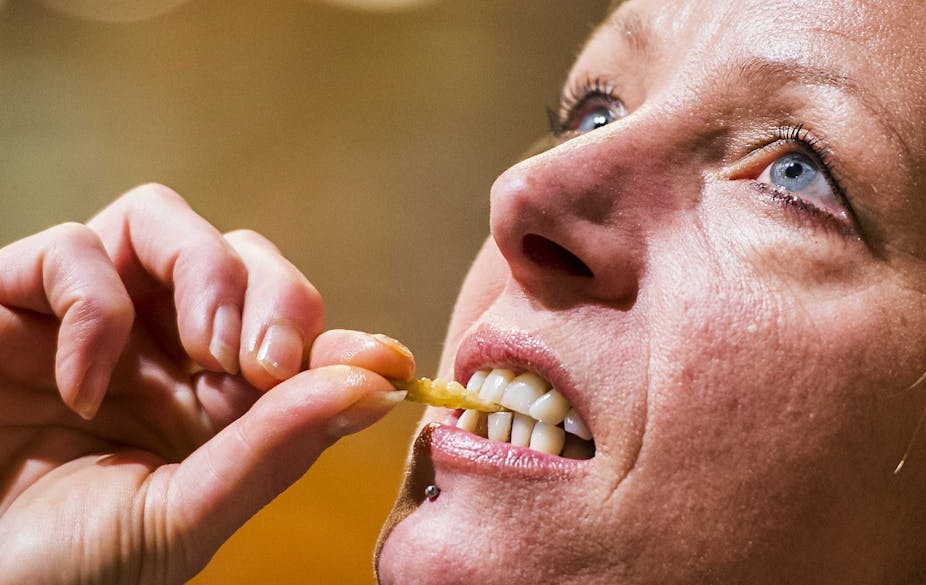There’s a lot of hype around edible insects. Insects are being championed as a healthy and sustainable alternative to conventional protein sources in Europe and the US, and “ento-prising” new products are appearing almost every week. Cricket-based cocktail bitters, anyone?
Of course, these new bug-based foods aren’t for everyone. In fact, in Western societies, they’re still not eaten by many people at all. But why is this, if they’re so good for us and for the planet?
First of all, there’s the “yuck factor”. According to many researchers and commentators, one of the main stumbling blocks is individual psychology – the stigma, aversion or disgust that many people in the West feel towards the idea of eating insects, and the subsequent rejection of insects as food.
Daniella Martin, a US advocate for insect consumption, has called this “the biggest obstacle” to Western acceptance of insects as food.
If only we could convince people to change their attitudes, the argument runs, then Westerners would all be snacking on chapuline grasshoppers rather than chicken nuggets.
However, this focus on individual psychology is problematic. It seems that the emphasis given to the yuck factor (or “ick factor”, as it’s also sometimes called) may be too great. Efforts to convince the unwilling public to eat insects may also not be the right approach to encourage wider acceptance.
New foods and early adopters
In the past, when new foods arrived in Western societies, the general public didn’t just suddenly decide to “accept” them following information campaigns or advertising. Research on the successful introduction of new foods such as sushi – or even, once upon a time, tea – suggests instead that they were first integrated into the diets of a handful of early adopters. This creates a relatively small but established market from which more widespread acceptance gradually develops. As such, it is probably more important to focus on people who are already willing to eat insects, rather than trying to convince those that aren’t.

But, crucially, the willingness of early adopters to eat a new food is not usually sufficient to encourage its wider uptake. Getting people to continue to eat a new food also depends on them being easily able to afford and access that food. It must also be easy enough for people to integrate the food into their existing culinary routines. And obviously the food needs to taste sufficiently good for people to choose to eat it instead of something else.
Successful establishment of a new food, no matter how unusual, relies on quite mundane and conventional considerations such as price, taste, availability, and how easily people can cook with it.
My research found that the same principles apply to the insect burgers and other insect-based convenience foods which have been on sale in Jumbo, a Dutch supermarket chain, since late 2014.
Going Dutch
The Netherlands is a leading light in efforts to develop insects as a sustainable new food source in Europe. Academics from Wageningen University were behind a landmark report on the subject from the UN’s Food and Agriculture Organisation in 2013, and – in addition to working on a €1m research project on the use of insects as a sustainable protein source – have produced an insect cookbook and given TED talks. Yet despite the relative prominence of edible insect advocacy, science, and products in the Netherlands, the uptake of the insect-based foods available there remains low.
My research found that among a group of willing early adopters of insect-based convenience foods, only a handful repeatedly consumed the products, because many of the social, contextual and practical requirements necessary to ensure repeat consumption were not met. People’s “willingness to eat” insects was generally high, but this alone did not account for how insects were (or were not) being integrated into their diets.
Anyone for seconds?
Much existing research in this area focuses on forecasting people’s initial willingness to eat insects, but downplays the influence that social context has on food consumption once foods are actually available in stores. Studies assume that if you show people pictures of imaginary insect foods, ask them to imagine being in a shop where insects are available, or ask them to sample insect burgers in a lab, that this will reveal their consistent attitudes towards insect eating – something that will later be reflected in their food choices.
But this isn’t necessarily the case. In the “real life” context of shopping and cooking, food consumption – whether for insects or more conventional products – tends to be determined by the social, contextual and practical factors such as the ones I have mentioned above. Indeed, the idea that an individual’s diet is primarily the result of a series of rational cost/benefit decisions has been criticised by social scientists investigating sustainable consumption, who argue that consumption is always affected by the many interrelated, routine social practices in which individuals participate.
So, although you may be motivated to eat insect products because of their healthiness or sustainability, a range of competing factors will ultimately affect whether insect products actually end up on your plate: when and where you shop, who you eat with and what other food you eat will all play a part.
These social and practical factors are not as newsworthy as the yuck factor or soundbite-friendly surveys projecting people’s likelihood of buying insect products. But my research suggests that how people are going to regularise their consumption of insect products will need to be a more important focus for both commercial and academic attention if insect foods are ever really going to fly.

